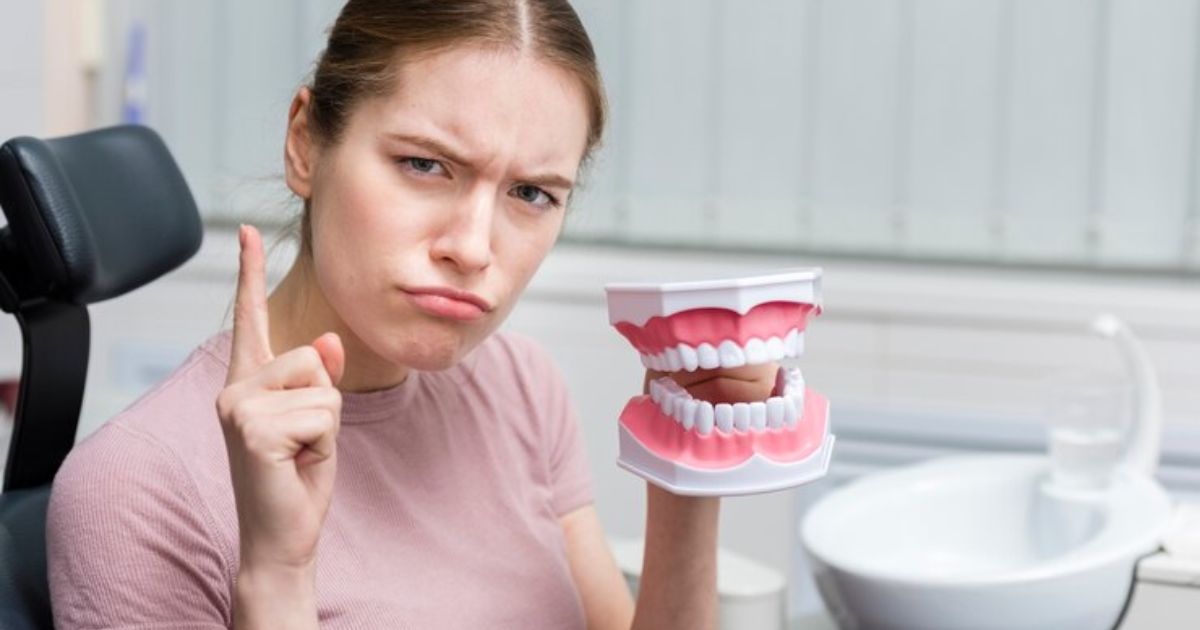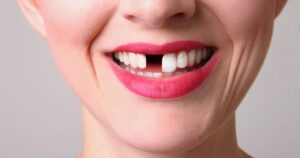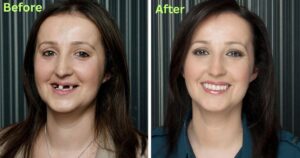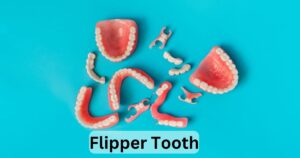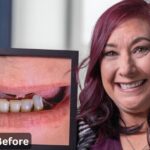Removing denture adhesive effectively is crucial for maintaining oral hygiene and ensuring comfort while using dentures. Denture adhesive, while instrumental in securing dentures in place, requires proper removal to prevent residue buildup and potential oral health issues. Understanding the correct techniques and products for adhesive removal contributes to a hassle-free experience. A well-informed approach involves gentle yet thorough methods to dislodge the adhesive without harming the denture base.
Why Do You Need Denture Glue Or Adhesive?
Denture glue or adhesive serves a crucial purpose in stabilizing and securing dentures in the mouth. Its primary function is to enhance the fit of the dentures by creating a bond between the prosthetic and the gums, thereby preventing slippage or movement during daily activities like eating, talking, or smiling. Several reasons necessitate the use of denture adhesive:
Enhanced Stability: For individuals with poorly fitting dentures or those experiencing frequent movement, adhesive helps improve stability, ensuring a snug fit.
Compensating for Bone Loss: Adhesive can compensate for bone loss in the jaw, providing added support for dentures.
Improved Confidence: By preventing denture slippage, adhesive boosts confidence, allowing individuals to speak and eat without fear of embarrassment.
Enhanced Comfort: Properly applied adhesive minimizes discomfort caused by ill-fitting dentures, reducing sore spots or irritation.
Temporary Solution: In situations where denture adjustments or replacements are pending, adhesive offers a temporary solution to maintain functionality and comfort.
While denture adhesive aids in securing dentures, it’s essential to use it sparingly and in accordance with the manufacturer’s instructions to avoid excessive buildup and ensure proper oral hygiene. Consulting a dentist can also provide guidance on the appropriate use of denture adhesive for individual needs.
How To Remove Dentures After Using Adhesive?
Removing dentures after using adhesive requires a careful and systematic approach to ensure comfort and avoid any damage to the dentures or oral tissues. Here’s a step-by-step guide:
Step 1: Rinse Mouth and Dentures
Before removal, rinse your mouth with warm water to loosen the adhesive. Gently swish and spit out the water. Similarly, rinse the dentures to remove any loose debris or food particles.
Step 2: Apply Gentle Pressure
To remove the dentures, apply gentle, downward pressure using your fingers. Start by slowly rocking the dentures back and forth to break the seal created by the adhesive. Avoid using excessive force to prevent damaging the dentures or causing discomfort.
Step 3: Use Warm Water
If the dentures are still firmly attached, rinse your mouth again with warm water. This can further soften the adhesive, making it easier to release the dentures.
Step 4: Employ a Denture Adhesive Remover
Consider using a denture adhesive remover recommended by your dentist. Apply it as directed on the adhesive to dissolve it gently. Follow the product’s instructions carefully.
Step 5: Clean Dentures and Oral Tissues
Once the dentures are removed, clean them thoroughly using a denture cleaner. Also, rinse your mouth with warm water to remove any remaining adhesive residue.
Step 6: Oral Hygiene
After denture removal, practice good oral hygiene by brushing your gums, tongue, and palate with a soft-bristled toothbrush to eliminate any residual adhesive and maintain oral health.
Step 7: Store Dentures Properly
Store the dentures in a denture cleanser or plain water to keep them moist and prevent warping or drying out.
Remember, if you encounter persistent difficulty in removing dentures or notice any changes in fit or comfort, consult your dentist promptly for guidance and adjustments.
Home Remedies for Effective Adhesive Removal
Here are some home remedies that can be effective for removing denture adhesive:
Warm Water and Mild Soap: Soaking the dentures in warm water with a mild soap or denture cleaner can help loosen the adhesive. Gently scrubbing the adhesive residue with a soft brush can aid in its removal.
Vegetable Oil: Applying a small amount of vegetable oil, such as olive oil or coconut oil, on the adhesive and allowing it to sit for a few minutes can help dissolve the adhesive. Afterward, rinse your mouth thoroughly with warm water.
Baking Soda Paste: Creating a paste by mixing baking soda with water and applying it to the adhesive can help break it down. Brushing gently with this paste can aid in adhesive removal.
Vinegar Solution: A solution of equal parts vinegar and water can act as a mild adhesive remover. Soak a clean cloth in the solution and gently wipe the adhesive residue, then rinse your mouth thoroughly.
Aloe Vera Gel: Aloe vera gel, known for its soothing properties, can help loosen denture adhesive. Apply a small amount to the affected area, let it sit for a few minutes, then rinse your mouth.
Saltwater Rinse: Rinsing your mouth with warm saltwater can assist in loosening the adhesive. Swish the solution around your mouth for a minute or two, then spit it out.
Why Do I Have To Remove Residual Denture Glue Anyway?
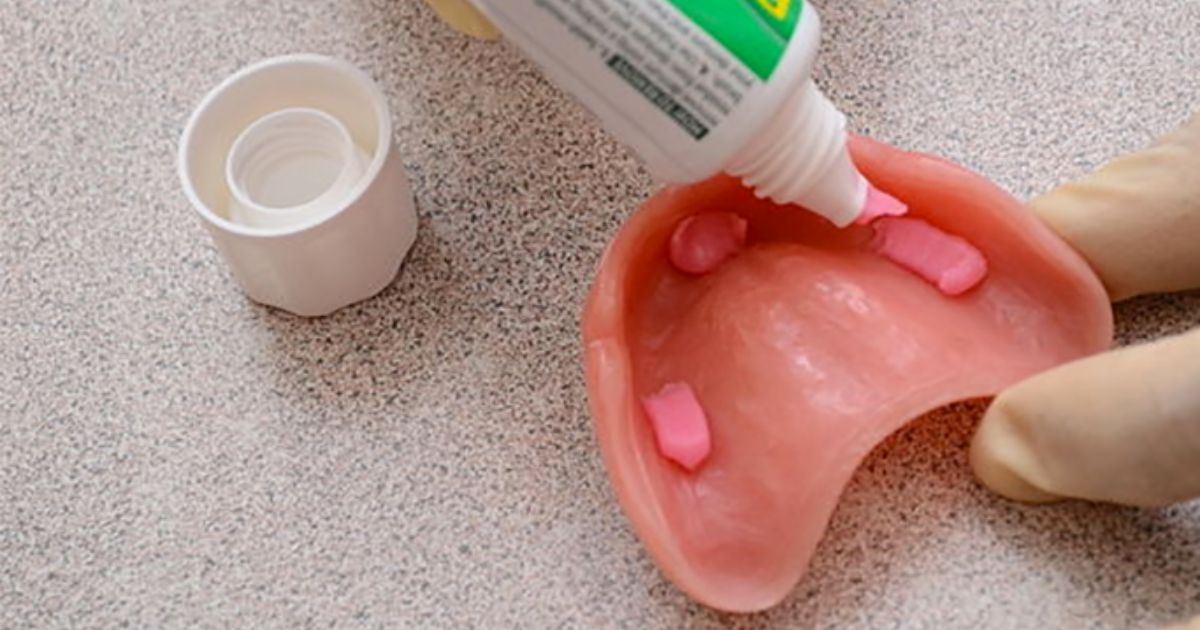
Residual denture glue, if left behind, can cause discomfort and compromise oral hygiene. Removing it is crucial to maintain comfort, oral health, and proper denture function. Removing residual denture glue is essential for several reasons:
Comfort: Leaving adhesive residue can cause discomfort, irritation, or soreness in the mouth, affecting your ability to wear dentures comfortably.
Oral Hygiene: Residual adhesive can harbor bacteria and food particles, leading to bad breath and potential oral health issues like gum irritation or infections.
Prevent Tissue Damage: Prolonged contact with denture adhesive residue may damage the soft tissues in your mouth, causing inflammation or sores.
Proper Denture Fit: Adhesive buildup can interfere with the proper fit of dentures, leading to instability or improper alignment, affecting your ability to chew or speak.
Maintain Oral Health: Removing residual adhesive ensures that your oral hygiene routine, including brushing and rinsing, is effective and doesn’t leave any buildup behind.
Prevent Denture Damage: Adhesive residue left on dentures may affect their longevity or appearance, making them harder to clean or causing discoloration.
By removing residual denture glue, you maintain oral comfort, promote oral health, ensure proper denture fit, and prolong the lifespan of your dentures while minimizing the risk of potential oral health complications.
Consider Why You Need Denture Glue?
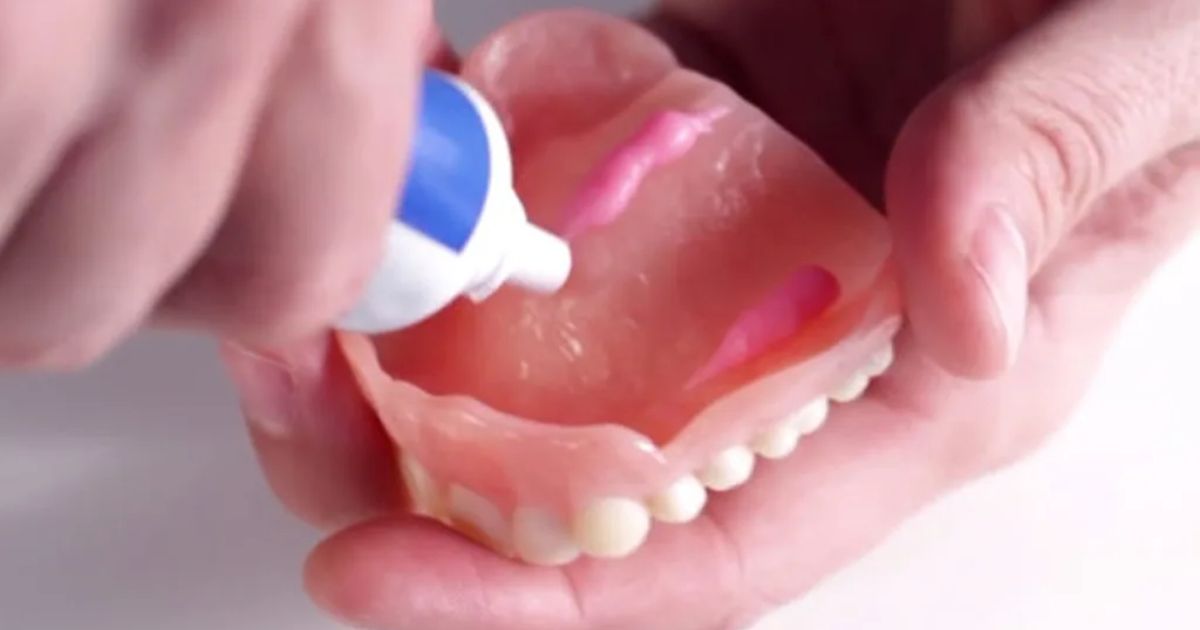
Denture glue, also known as adhesive, is essential for securing dentures in place. It ensures a snug fit, preventing movement or slippage while eating, speaking, or smiling. This adhesive creates a bond between the denture and gums, offering stability and boosting confidence. Its application is crucial, especially for ill-fitting dentures, providing comfort and a sense of security in daily activities.
Common Mistakes to Avoid
Avoiding these mistakes ensures proper denture care, comfort, and oral health. Regular dental check-ups and adherence to care instructions are vital for optimal denture use. These common mistakes can help ensure effective denture care:
Excessive Adhesive: Using too much denture adhesive can lead to oozing, discomfort, or difficulty in removing the dentures.
Improper Cleaning: Neglecting to clean dentures thoroughly can result in bacterial buildup, affecting oral health.
Skipping Regular Check-ups: Missing dental appointments can lead to unnoticed issues with denture fit or oral health.
Ignoring Irritation: Overlooking sore spots or irritation caused by dentures can worsen discomfort and affect oral tissues.
Not Following Instructions: Incorrect application of adhesive or improper denture care can impact their effectiveness and longevity.
Using Adhesive on Ill-Fitting Dentures: Using adhesive as a fix for poorly fitting dentures rather than seeking adjustments from a dentist can worsen the issue.
FAQ’s
What is the easiest way to remove denture adhesive?
One especially successful method involves using a damp exfoliating glove to rub the glue off dentures under warm running water. The same glove can be useful for removing residual glue in your mouth.
How can I remove dentures at home?
For upper dentures, ease them by gently pressing between the denture and cheek. Apply even pressure along the gum line. For lower dentures, use your thumb and fingers on each side to remove them.
What is the fastest way to clean dentures?
To clean dentures, take them out and apply hydrogen peroxide directly to its surfaces.
What is the best cleaner for dentures?
Salt and baking soda are two brilliant natural cleansers that you can combine with glycerin to make your own gentle, safe and effective toothpaste if this is how you prefer to clean your dentures.
What is the safest way to clean dentures?
Remove and gently clean your dentures daily. Soak and brush them with a soft-bristled brush and nonabrasive denture cleanser to remove food, plaque and other deposits.
Conclusion
Successfully removing denture adhesive is pivotal for oral comfort and hygiene. Proper techniques, like gentle rocking motions and rinsing, ensure the safe removal of dentures without causing discomfort or damage. Maintaining oral health post-removal is equally important, with thorough mouth rinsing and gentle cleaning to eliminate any residual adhesive. Home remedies like warm water, mild soap, or natural agents aid in the gentle dissolution of adhesive residue.
However, caution must be exercised to prevent irritation or injury to oral tissues. Regular dental check-ups offer guidance on effective adhesive removal and denture care. By adhering to these practices, individuals can ensure a comfortable denture-wearing experience, prevent oral complications, and promote overall oral well-being. The key lies in a balanced approach—gentle yet effective—ensuring the safe removal of denture adhesive while prioritizing oral health and comfort.
